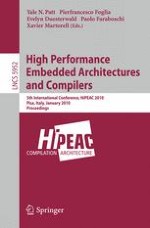2010 | Buch
High Performance Embedded Architectures and Compilers
5th International Conference, HiPEAC 2010, Pisa, Italy, January 25-27, 2010. Proceedings
herausgegeben von: Yale N. Patt, Pierfrancesco Foglia, Evelyn Duesterwald, Paolo Faraboschi, Xavier Martorell
Verlag: Springer Berlin Heidelberg
Buchreihe : Lecture Notes in Computer Science
